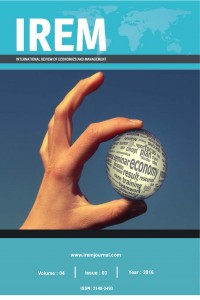Yıl 2013,
Cilt: 1 Sayı: 1, 38 - 48, 19.06.2015
Öz
Kaynakça
- Cobb, C.W., & Douglas, P.H. 1928. A Theory of Production. The American Economic Review, 18: 139-165.
- Robinson, J. 1953-1954. The Production Function and the Theory of Capital. The Review of Economic Studies, 21: 81 -106.
- Solow, R.M. 1957. Technical Change and the Aggregate Production Function. The Review of Economic Studies, 39: 312-320.
- Fisher, F.M. 1968. Embodied Technology and the Aggregation of Fixed and Movable Capital Goods. The Review of Economic Studies, 35: 417-428.
- Garagnani, P. 1970. Heterogeneous Capital, the Production Function and the Theory of Distribution. The Review ofEconomic Studies, 37: 407-436.
- Rowley, J.C.R. 1972. Investment and Neoclassical Production Functions. The Canadian Journal of Economics, 5: 430-435.
- Spanel, J., & Sling, M. 1977. The Production Function, Absorption Capacity of the Economy, and Reproduction of Capital Assets. Eastern European Economics, 15: 3-16.
- Faurot, D.J. 1978. Interrelated Demand for Capital and Labor in a Globally Optimal Flexible Accelerator Model. The Review of Economics and Statistics, 60: 25-32.
- Spiegel, Y. 1996. The choice of technology and capital structure under rate regulation. International Journal of Industrial Organization, 15: 191-216.
- Beneito, P. 2003. Choosing among alternative technological strategies: an empirical analysis of formal sources of innovation. Research Policy, 32: 693-713.
- Istaitieh, A., & Fernandez, J.M.R. 2006. Factor-product markets and firm’s capital structure: A literature review. Review of Financial Economics, 15: 49-75.
- Parker, E., & Pingle, M. 2006. The distributional effects of selection and capital accumulation on firm productivity under imperfect capital markets. Empirical Economics, 31: 677-697.
- Toimura, E. 2009. Foreign versus domestic outsourcing: Firm-level evidence on the role of technology. International Review of Economics and Finance, 18: 219-226.
Yıl 2013,
Cilt: 1 Sayı: 1, 38 - 48, 19.06.2015
Öz
Production process has utmost importance on a firm’s survival in a competitive market. For this purpose, firms from developed countries choose to produce in different parts of the world to benefit from cheap labor supply. On the contrary, firms in developing countries prefer to import capital goods from developed countries to increase their chance to survive in a harsh competitive environment. But these capital goods are designed and optimized specially for the firms in developed countries. Thus, it is unclear whether the strategy of firms in developing countries is beneficial or not. In this paper, we clarify the results of firms’ strategies from both developed and developing countries. Theoretically, the strategy of firms that originated from developed countries is profitable. On the other hand, the strategy of firms in developing countries harms their profit levels.
Anahtar Kelimeler
Kaynakça
- Cobb, C.W., & Douglas, P.H. 1928. A Theory of Production. The American Economic Review, 18: 139-165.
- Robinson, J. 1953-1954. The Production Function and the Theory of Capital. The Review of Economic Studies, 21: 81 -106.
- Solow, R.M. 1957. Technical Change and the Aggregate Production Function. The Review of Economic Studies, 39: 312-320.
- Fisher, F.M. 1968. Embodied Technology and the Aggregation of Fixed and Movable Capital Goods. The Review of Economic Studies, 35: 417-428.
- Garagnani, P. 1970. Heterogeneous Capital, the Production Function and the Theory of Distribution. The Review ofEconomic Studies, 37: 407-436.
- Rowley, J.C.R. 1972. Investment and Neoclassical Production Functions. The Canadian Journal of Economics, 5: 430-435.
- Spanel, J., & Sling, M. 1977. The Production Function, Absorption Capacity of the Economy, and Reproduction of Capital Assets. Eastern European Economics, 15: 3-16.
- Faurot, D.J. 1978. Interrelated Demand for Capital and Labor in a Globally Optimal Flexible Accelerator Model. The Review of Economics and Statistics, 60: 25-32.
- Spiegel, Y. 1996. The choice of technology and capital structure under rate regulation. International Journal of Industrial Organization, 15: 191-216.
- Beneito, P. 2003. Choosing among alternative technological strategies: an empirical analysis of formal sources of innovation. Research Policy, 32: 693-713.
- Istaitieh, A., & Fernandez, J.M.R. 2006. Factor-product markets and firm’s capital structure: A literature review. Review of Financial Economics, 15: 49-75.
- Parker, E., & Pingle, M. 2006. The distributional effects of selection and capital accumulation on firm productivity under imperfect capital markets. Empirical Economics, 31: 677-697.
- Toimura, E. 2009. Foreign versus domestic outsourcing: Firm-level evidence on the role of technology. International Review of Economics and Finance, 18: 219-226.
Toplam 13 adet kaynakça vardır.
Ayrıntılar
| Birincil Dil | İngilizce |
|---|---|
| Bölüm | MAKALELER |
| Yazarlar | |
| Yayımlanma Tarihi | 19 Haziran 2015 |
| Gönderilme Tarihi | 19 Haziran 2015 |
| Yayımlandığı Sayı | Yıl 2013 Cilt: 1 Sayı: 1 |


